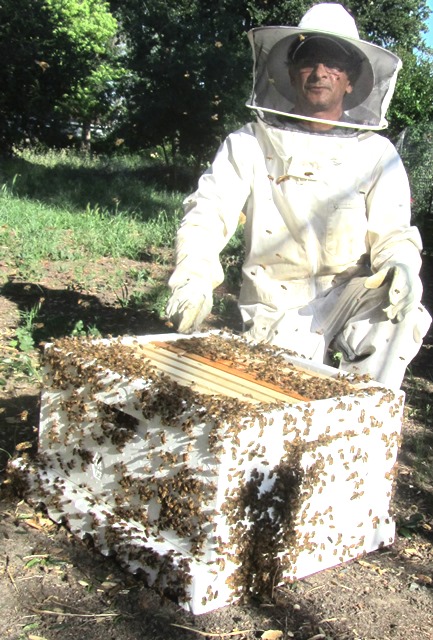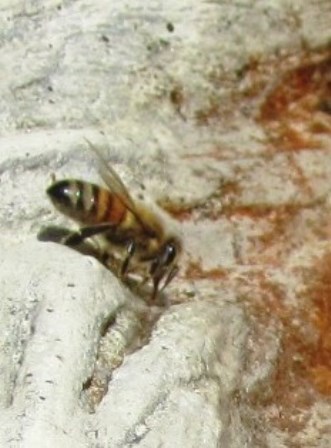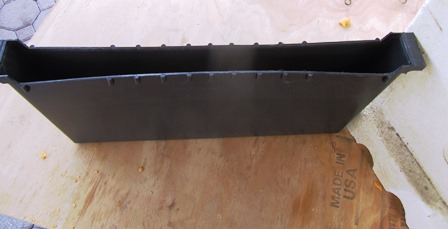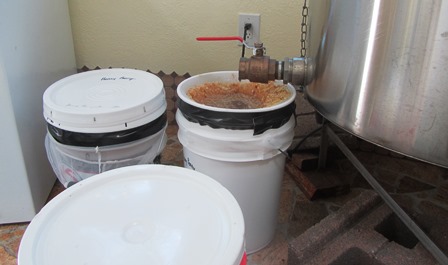Archive for the 'Wildlife' Category
Killer Bees Found for the First Time in the East Bay
Global warming might be responsible for our extreme summer heat and the multi-year drought in the Bay Area. It might also explain the presence of killer bees, too. For the first time, U.C. San Diego scientists tracking the Africanized honeybees have found them here in the East Bay city of Lafayette.
The Oakland Tribune suggests the Africanized honeybees are docile unless their hive is threatened. Otherwise, the Africanized or “killer bees” are of similar temperament and have a similar sting as the European honeybees. See, http://www.insidebayarea.com/breaking-news/ci_28892198/killer-bees-detected-lafayette-bay-area-first-time?source=rss
The Africanized bees were bred with European honeybees in Brazil in 1956 to produce a honeybee better suited to Brazil’s climate. The bees escaped their containment, bred with European bees and spread.
The Africanized bees breeding with European honeybees quite possibly means the resulting bees may have a stronger resistance to one of diseases believed responsible for European bee die-offs and colony collapse disorder.
Widely published stories today tell us that the killer bees have been detected in Briones Regional Park in Lafayette, only ten miles from where I keep bees on the Henny Penny Farmette.
Researchers from U. C. San Diego have tracked the bees throughout the state. Likely more than one colony has been established here. But whether or not the bees stay remains to be seen. See, http://www.sfgate.com/bayarea/article/Killer-bees-found-in-the-Bay-Area-for-the-6535892.php
Bees prefer warmer, drier habitats, so they may not stick around. The strong El Nino forecast for this winter could bring much needed rain to the Bay Area and plunging temperatures to the freezing mark.
Africanized bees swarm relentlessly when they perceive a threat. If you are out walking and notice bees foraging on wildflowers, become vigilant. They may not bother you. But do observed them. Don’t swat at them, it will antagonize the bees.
If they start moving toward you, run to at least 100 yards away. Retreat indoors if possible. Don’t think you can escape by jumping into a lake or pool. Researchers say the killer bees have been known to wait above the water.
To read an in-depth analysis of the Africanized honeybee, see http://www.library.ca.gov/crb/99/notes/v6n2.pdf.
To curl up with a cozy mystery that features gentle honeybees, check out my newest novel, A BEELINE TO MURDER: http://www.amazon.com/s/ref=nb_sb_noss?url=search-alias%3Dstripbooks&field-keywords=Meera+Lester&x=0&y=0
Put Your Eyes and Nose on Your Hives
As a beekeepeer, I sniff my hives as well as visually examine them for signs of hive health. A healthy hive smells pleasant but an unhealthy one can emit a foul odor.
This time of year, honeybee hives should be checked for populations of mites. Especially destructive is the Varroa destructor mite and the tracheal mite. Mite populations can rapidly increase and decimate a hive.
The Varroa destructor mites are true “blood suckers” and feed on adult bees (especially drones or males) and baby bee larvae.
I inspect for deformed bees (like wings missing), red or brown spots on bee larvae, or pinpoint-size mites (looking like ticks) clinging behind a bee’s head or between its abdominal sections. It’s best to treat immediately when the signs are clear that there’s a problem in the hive. If it smells foul, there could be an infection.
In fact, beekeepers need to stay vigilant for all kinds of illnesses that can harm their hives: mites, bacterial infections, and/or even predators placing hive’s health at risk.
The scent of honey and the hum of bees busily working inside the hives can be reassuring to a beekeeper, but doesn’t eliminate the need for regular inspections, especially in autumn. You want your hives to be healthy enough to make it through whatever conditions winter brings.
For bee tips, recipes, and a killer cozy mystery, check out my newest offering: A BEELINE TO MURDER. See, http://tinyurl.com/ptegs9g
To Feed or Not to Feed the Bees?
Mid-September is a time when beekeepers check their hives and consider the prudence of harvesting more honey or leaving it as well as whether or not to feed the bees. Honeybees, like many living creatures on our planet, need food and water to survive.
My wise beekeeper neighbor tells me that the hive needs to have sixty pounds of honey to make it through winter. He’s feeding his bees now a mixture of sugar and water.
The sugar-water inserts are black plastic holders that get inserted right into the hive in place of a frame. They are rigid enough to hold the sugar-water but pliant enough to swell outward, so conventional wooden frames of honey and wax help them stay in place. The downside is that bees can drown in these feeders. And if the beekeeper lets them go empty, the enterprising bees will just build comb and honey inside them.
There are several kinds of feeders–all with benefits and also drawbacks. For more information on feeders, see: http://www.honeybeesuite.com/what-type-of-honey-bee-feeder-is-best/
Last year, I didn’t take honey in the fall. I wanted to ensure the bees had what they needed to survive after they’d been through yet another summer of drought. There aren’t a lot of pollen-rich flowers to be found now. However, star-thistle still dots dry hillsides of Contra Costa County (where I live) and particular eucalyptus species that the bees like are blooming now.
I’m hopeful that this will be the last year of drought for a while. Weather forecasters say we have a strong El Nino that’s formed and will likely bring rain during our rainy season (November through April). That will be good news for the bees and those of us who love to plant flowers in our gardens to attract pollinators. But until the wet stuff starts coming down and new pollen sources are abundant, we beekeepers need to keep a close watch on our industrious little honeybees.
Deadline Nears for My Debut Novel Giveaway
It’s not too late to enter the Goodreads giveaway of A BEELINE TO MURDER, my debut novel from Kensington Publishing. This is the first book in the Henny Penny Series, set in a farmette milieu and featuring sleuth Abigail Mackenzie, a former cop turned farmette owner.
The murder of a small town’s celebrity pastry chef remains central to this cozy mystery, however, Abby must juggle chores on the farmette (a foreclosed property she acquired that needs clearing, cleaning, and restoration) with paying detective work. Although she keeps bees and chickens and sells her organic honey, eggs, and heirloom produce, the income is never enough to pay the bills and fund the renovation work.
The concept for this series came about as a result of my purchase of the real Henny Penny Farmette–a rundown property that I bought in 2009. The work of bringing the land back to life and renovating the house is some of the hardest work I’ve ever done. And it seems it will never end.
Like the protagonist of my novel, I keep bees and chickens. I grow heirloom vegetables and tend the dozens of fruit trees I’ve planted.
I draw upon real life issues involving weather, wild and domesticated animals, human relationship conflicts, and community dramas to seed the background of my murder mysteries.
I love writing about the people in the fictional small town of Las Flores. Except for growing up on a farm in the Midwest and spending two years in Miami, I have lived in Northern California’s cities and small towns for most of my life. Drawing upon the peculiarities of small town life, I have created the community of Las Flores with vivid details that I hope will ring true for my readers.
The deadline to enter the drawing for A BEELINE TO MURDER is August 31 (Monday). I hope you’ll take a moment to join the fun. You might just win one of the 25 copies being given away. See, https://www.goodreads.com/giveaway/show/147966-a-beeline-to-murder
Why We Should Love Toads
What is brown, relatively smooth-skinned, and burrows into dry soil in Western gardens? The answer is the Western spadefoot toad, and there are plenty of reasons to invite them them into making their home near yours.
They like to dine on cutworms, flies, grasshoppers, slugs, grubs, wood lice, and other small insects. In fact, a single spadefoot toad will eat roughly 10,000 to 20,000 insects a year. And that’s just from spring until fall, when they go into hibernation.
After eating all those insects, you’d think they might head for your vegetable patch or flowers. But no, they aren’t interested in harming your herbs, flowers, or veggies.
We can help these toads set up housing in our gardens by creating a shallow impression in the soil and placing a board or two over it, leaving just enough room for the toad to hop in. For an image and to hear the sound of the spadefoot toad, see: http://www.californiaherps.com/frogs/pages/s.hammondii.html
Like most living creatures, they need water. A water garden, pond, or even a ground-level plant saucer or bird bath will do the trick. An added benefit of a water garden or small pond is its attractiveness to toads to lay their eggs, ensuring generations of toads in your garden for years to come.
Protecting Your Backyard Flock in a Heat Wave
I lost a chicken this morning despite taking measures to protect her from the deadly heat wave we’ve been having here in the Bay Area. The last thing someone attached to their hens ever wants to see is one of her precious little girls gone. Mine was a Silver Laced Wyandotte (who leaves behind a sister) and five other hens with whom she was raised.
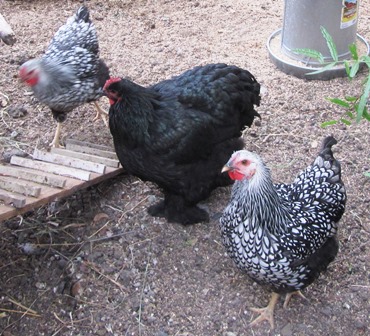
The Silver Laced Wyandotte (black-and-white) hen in the foreground succumbed to the extreme heat sometime during the night
Our farmette sits in the east bay hills and too far inland from the San Francisco Bay or the delta (which flows to Sacramento) to gain much benefit from cooling breezes off the ocean. We’ve had triple digit temps on the farmette for days.
I put out extra water basins for my chickens, kept their doors open in the chicken house at night (there is a wire run with a wire ceiling to protect them when they’d rather roost outside), and fed them frozen corn, cool seedless watermelon treats, and chilled grapes.
The chicken house has windows that I keep open (they have reinforced wire over the screens). I reduced the amount of litter on the floor (I use ground corn cob) since it could hold the heat.
I haven’t install a fogging system or fans, but I might if this heat keeps up.
The only telltale sign that my hen was in trouble was that she seemed to exhibit lethargy and to have lost weight (although it was difficult to tell under all her feathers).
Her comb had turned slightly pale and seemed to have shrunk in the last 24 hours. When I check on her last night she was turning herself to face the wall. Not a good sign since, in my experience, I’ve seen chickens do this before they pass away.
Some strategies for helping backyard chickens survive extreme heat include the following tips.
Eight Strategies to Help Chickens Beat the Heat
1. Make sure windows of chicken houses face north to south to allow breezes to blow through, rather than face east to west (rising and setting sun).
2. Keep litter on the chicken house floor low (1 to 2 inches is sufficient).
3. Position your chicken house under a tree, if possible, where the structure receives shade.
4. Make certain you have several watering dispensers (placed in the shade) with clean, fresh water every day during hot weather.
5. Add ice cubes to the watering canisters.
6. Put out treats such as bowls of frozen corn and cool, seedless watermelon, and chilled grapes or blueberries.
7. Use a fan, if necessary to remove heat from the chicken house.
8. As an emergency measure for a chicken that looks distressed, dip her in cool water.
Update on the Buffo Broodzilla
My Buff Orpington hen, who’d been sitting on a couple dozen infertile eggs for weeks–some rotten and others broken–finally left the nesting box after I removed all the eggs. I’ll be set up for baby chicks next year in my hen house, but not now.
At first, she continued to display her broodzilla behaviors (aggressive, flighty, angry) and was easily set off by the antics of the other chickens. However, within a day or two, she’d normalized her old laying routine and began running with the other hens as they foraged around the farmette, took dust baths, clamored for chicken snacks, and pecked at each other.
My neighbor told me to dunk her in cold water to break her broody cycle. That’s because hens who go broody have an elevated body temp. Removing the eggs worked this time; maybe next time, I’ll try cooling her off. Or . . . if it happens in the spring, I might get some baby chicks and let her raise them.
I’m certain there will be a next time–she’s gone broody three times in a year and half. Some hens have that tendency.
Consider This Before You Get Backyard Chickens
My bedroom window faces the back of our property where the chicken coop sits. Every morning, I’m awakened by repeated grauwkkkk sounds made by the Silver Laced Wyandottes and the Rhode Island Red hens, the noisiest ones of all my chickens.
I wish I’d read up more on the breeds before making my selections at the feed store. I love keeping chickens and the eggs are fabulous. That said, there are some of the areas I wish I’d known more about. I might have chosen different breeds.
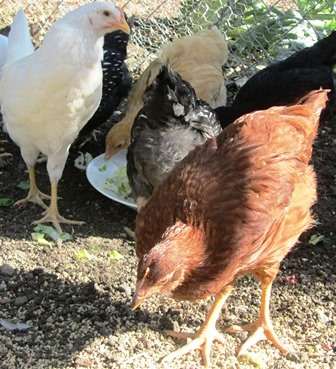
Rhode Island Red hen seems to be at the top of the pecking order in this small flock of backyard chickens
1. Noisemakers–some breeds are noisier than others. I seldom hear the occasional cluck from my White Leghorns, but the Wyandottes never seem to shut up. Get a bunch of hens together and conversing, and you’ll soon see what I mean.
2. Snacking–chickens love snacks but give them judiciously. If they consume too many treats like blueberries, fresh corn from the cob, and bits of bread or rice, the quality of their eggs may suffer. But as soon as you give them treats, they become your best friends and will follow you around.
3. Pecking–chickens quickly establish a pecking order; they will also peck you . . . some harder and more aggressively than others. My Black Sex Link hen just seems kind of mean and pecks with impatience. But the Rhode Island Red will give an almost loving peck that’s not hard and doesn’t hurt.
4. Broodiness–when a hen goes broody (like my Wyandotte and Buff Orpington hens), her hormones have told her she needs to sit on a clutch of eggs until they hatch (about three weeks). But if you do not have a rooster to have fertilized those eggs, the hen will sit on them anyway, tying up a nesting box and hoarding eggs that will have to be tossed out when she finally figures out that she’s engaged in a futile pursuit of baby chicks. Some breeds tend to broodiness more than others.
5. Water and Food–chickens need water, love crumble, and can benefit from a serving of cracked grains and dried worms. To ensure their egg shells are sufficiently rigid, they may also need additional oyster shell calcium. And like all living beings they need fresh water. If they go without water, they can stop laying for weeks. I’ve figured out the cracked grains must be so tasty they are like cotton candy and after them, the hens don’t want their good food.
6. Diminishing Returns–hens begin laying when they are about five months old. After the first year, egg production will fall off about 20 percent in subsequent years. They generally lay eggs for seven or eight years, but can live to be older and produce no eggs.
7. Egg size–when a hen tries to lay too large of an egg, it can cause a condition called cloaca prolapse. It can claim her life–I’ve lost two chickens to this problem. One was an Ameraucana heritage chicken that laid blue-green eggs. I do miss her as she was skittish but quiet.
8. Moving Hens or a Rooster–if you are getting the gift of a chicken from a neighbor or friend, move that chicken into the flock at night. When he or she wakes up in the morning, the whole event will be a fait accompli and will generate less stress for all involved.
Pulling Honey–A Bee-eautiful Sight to See
Nothing compares to the reward of pulling honey from a hive when you are a beekeeper. Over the last two days, this is what I’ve done with the help of my world-class beekeeper neighbor who knows more about keeping honeybees than anyone I’ve ever met.
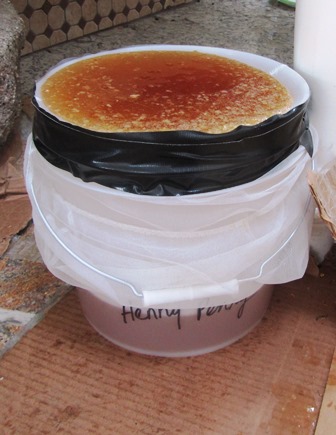
Pictured is a Henny Penny Farmette honey bucket with strainer taped on and bits of wax in the honey on top
His wife helped me scrape off the bee glue from each frame and then open the capped cells (a must) before draining the honey. We then used their machine that can spin twenty frames at a time. It has an electric motor and a control to increase or decrease the speed. Use slow speed to begin and then when the frames grow lighter, you increase the speed.
In all, I spun four hive boxes full (ten frames each), except for one box that had fewer because we left two frames behind in the apiary. They still had babies in them.
We taped fine-mesh filters over the tops of several five-gallon buckets. To spin the honey out of the first eighteen frames took many hours, from noon to about ten o’clock at night. We left the machine spigot open all night to allow the draining to continue into the bucket. The filters caught bits of wax and even the occasional dead bee, ensuring the honey would be perfectly clean and ready to bottle.
I drained honey from the ten frames in each of my hive boxes–two of my hive boxes held the large frames and two held smaller frames. In all, we spun and drained enough honey to fill three five-gallon buckets and about one-fourth of a two and one-half gallon bucket.
Not a bad yield for a fairly young hive and during summer in a drought year when pollen-laden flowers are not be as plentiful. It’s a bee-eautiful sight to see!
Ants in the Freezer . . . Seriously?
Well, this is embarrassing. I found ants, a big pile of them, in the bottom of the freezer side of my double-door fridge. I thought it was a mound of spilled coffee grounds. But that made no sense. Why would ants venture into the freezer in the first place. Crazy as it seems, I have an idea.
A few weeks ago, my beekeeper neighbor told me about a little trick to sterilize frames before putting them into the hives. He said after I have drained a frame of honey, I should hang it outside in a tree near the hives for the bees to clean (they will eat the honey but leave the wax).
Then, I should put the frame of wax in a freezer so that any tiny pest like the larva of a wax moth or mites or ants will be killed.
After 24 hours, I can remove the frame from the freezer and store it until I’m ready to put it into a hive box. When I harvest honey, I can easily replace a honey-filled frame with an empty frame that has been sterilized in the freezer and already has beeswax. It’s less work for the honeybees to use that frame for brood or honey. Sounds good, right?
Well . . . I wrapped two frames with aluminum foil before putting them in the freezer. But I got lazy and just inserted one frame into the freezer without first wrapping it. It seemed very clean–just white wax left by the bees after they had devoured all the honey.
The unwrapped frame I put in my kitchen freezer must have leaked a drop or two of honey that I didn’t see. It drew those ants. Serves me right.
Now I have a designated freezer to be used only for honeybee frame sterilization. It will stand outside on my patio. I’m pretty sure the ants won’t be visiting my kitchen again. At least, that’s what I’m hoping.
 Facebook
Facebook Goodreads
Goodreads LinkedIn
LinkedIn Meera Lester
Meera Lester Twitter
Twitter




